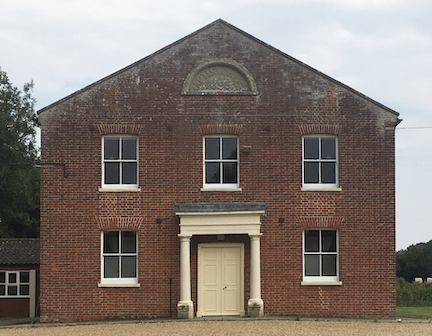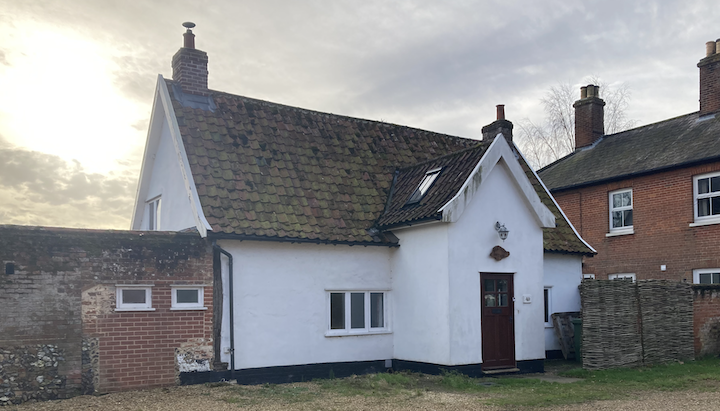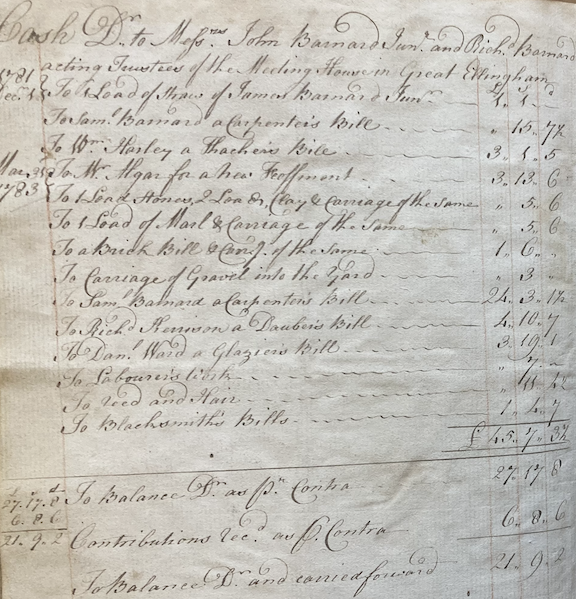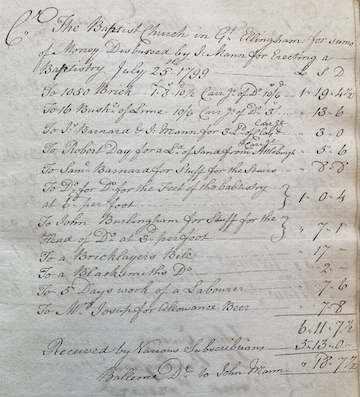Members of the Baptist Church have met together in Great Ellingham since at least 1699.

The semi-circular tablet in the front wall of the chapel gives the year ‘1699’. However this is the year of the formation of a Baptist Church in Great Ellingham, and not when the building was built. The chapel was built much later in 1824. So, where did the Baptist’s meet?
Elizabeth Asty’s Barn
David Bugden mentions in his informative book, “The story of 300 years of the Baptist Church at Great Ellingham”, that members “began to meet in a barn made available by a certain Elizabeth Asty who subsequently joined the church”.
I wonder whether ‘the barn’ was actually the stables and bakehouse which Elizabeth Asty mentions in her will of 1724. Asty bequeathed her cottage, land, bakehouse and stables to the Trustees of the Baptist Church. It was her wish that her cottage be used to house the Baptist Minister. She also instructed her Trustees to enlarge the bakehouse and stables. I believe this is the building which became known as the “Meeting House”.

‘Elizabeth Asty’s House’ in Long Street
Photograph taken November 2024
On the 6th May, 1792, the Meeting House was formally certified as a place designated and set apart for the Religious Worship of Protestant Dissenters.
Maintenance
Various entries in the Baptist Church Accounts Book provide details of the materials used for the maintenance of the cottage and Meeting House. The same Accounts Book also gives us the names of the tradesmen who either provided the materials, or worked on the buildings.
1783

Extract from Great Ellingham Baptist Church Accounts Book 1781-1837
Courtesy Hugh Collier & The Great Ellingham Baptist Church
The accounts for March 31st, 1783 mentions dauber Richard Kerrison, carpenter Samuel Barnard, glazier Daniel Ward and thatcher William Harley. Bills were paid for the supply and carriage of bricks, stones, clay, reed and hair, straw and marl.
1790
In 1790, further work was carried out for the ‘Reparation of the Meeting House, Dwelling House and Yards’ which involved work carried out by a carpenter, blacksmith, glazier, bricklayer, thatcher and dauber with bills for bricks and nails.
At a similar time, additional work was carried out which included work regarding a sloosegate [most probably a water channel] and work at the Vestry Door.
1795
In December 1795, the Trustees paid out the sum of one shilling for ‘outholling’ [the clearing of mud] between the 2 gates against The Street.
1796
An amount of straw for the cottage was purchased in December 1796 along with the payment of the bills from a thatcher, carpenter and bricklayer. The total sum amounted to £6 2s 7d.
Carpenter Samuel Barnard was paid £1 3s 4d for providing a stepping block.
1799

Extract from Great Ellingham Baptist Church Accounts Book 1781-1837
Courtesy Hugh Collier & The Great Ellingham Baptist Church
The above extract from the Baptist Church Accounts Book lists the payments made by ‘J. Mann for Erecting a Baptistry’ in 1799. John Mann was Deacon of the Baptist Church at this time.
Maintenance to the Meeting House and the cottage was ongoing. The names of tradesmen Richard Kerrison and Samuel Barnard frequently appear in the accounts during this period. At one time, Samuel Barnard had his carpenter’s shop at the property we know today as Glenfield House/Glenfield Cottage.
1800-1801
The accounts for 1800, show that Richard Kerrison was paid 6s 2d (six shilling and tuppence) for ‘whitening ye Meeting House’.
In 1801, the Trustees paid out 3s 6d for the cleaning of ‘the Meeting House after whited”. There is also an entry for the sum of 7½d in relation to an allowance of beer to ‘Painters’ which appears to connect to the Glaziers work at 5/- (five shillings).
Great Ellingham Inclosures
At the time of the Great Ellingham Inclosures c.1802, the Trustees of the Baptist church held two messuages and 5 acres of land. The Inclosure documentation also confirms that all the property and land is freehold and is occupied by John Ewing. Ewing had been the Baptist Minister in Great Ellingham from 1790 and would continue until 1803, when he was succeeded by Charles Hatcher.
1803-1806
In June 1803, three men were paid 5s 3d for a day’s work for ‘cutting a water course to baptist pit’.
In 1806, work was carried out for the thatching and roofing of the Meeting House. The building was again whitened. Work was also carried out in the yard.
1817-1824
Further work was carried out to the Meeting House and Barn in 1817. £2 5s 0d was spent on straw. Thatcher S.Howchin [Stephen Houchen] was paid £1 12s 2d for his work. T. Kerrison was paid £1 3s 10d for whitening the House.
In the Spring or early Summer of 1822, Samuel Barnard, Robert Houchin and Edmund Kerrison all carried out work at the Meeting House.
Completion of the Baptist Chapel in 1824
The Meeting House continued to be used by the Baptist Church until November 1824, when the present Baptist Chapel was completed. However, the ‘old’ Meeting House continued to be used by members of the Baptist Church.
1829
In June, 1829 William Pea was paid 12/6d for whitening the Meeting House. The bill for the lime came to 3/6d. Charles Clarke was paid 6/3d for his work in relation to the Meeting House.
Public Worship in the Cottage
In his entry of 1849 in the Minute Book of the Baptist Church (1849-1868 ), Pastor James Cragg mentions that the Congregation frequently assembled “for public worship in the cottage on the premises, in preference to the Chapel from the smallness of their numbers.”
Request for Suitable Residence
It was also around this time that Minister James Cragg recorded his thoughts with regard to the Pastor’s accommodation. He writes “A suitable residence for the pastor of the Church is absolutely needed, the present residence carrying with it the imperfections of age..” He goes on to say that the “…absence of domestic comfort is unhealthy, inconvenient and repulsive, and unsuitable”.
In the event, new accommodation for the Baptist Minister was subsequently built near to the cottage once owned by Elizabeth Asty and near to the Baptist Chapel. However, James Cragg continued to live at the cottage until the Manse was built c.1852.
The Cottage & Meeting House
The Meeting House and the cottage continued to be owned by the Trustees of the Baptist Church. Following James Cragg’s move to the new Manse, the cottage had new occupiers and the Meeting House continued to be used for church business.
Today the Meeting House has long gone. However ‘Elizabeth Asty’s delightful cottage’ still stands near to the Baptist Chapel and the Manse.
Sources:
Great Ellingham Baptist Church Book 1781, Register of Births etc (Baptist Chapel) Great Ellingham No.2 Book, Baptist Church, Great Ellingham Minute Book September 29th 1849. Baptist Church Book inc. Minutes 1868-1903. Misc. Correspondence & documents. Thanks to Great Ellingham Baptist Church & Hugh Collier
The Story of 300 years of the Baptist Church at Great Ellingham – David Bugden
1799-1842 F W Horner, Records of the Surveyors to Commissioners for Inclosure in Parishes in Norfolk and Suffolk. Great Ellingham (Act 1799). Norfolk Record Office. Catalogue Ref: NRO, BR 90/2
Will of Elizabeth Asty. Norfolk Record Office. ANF will register 1721-1726. fo.344 (1724-1726 no.64) Asty, Elizabeth of Great Elingham, 1724-1726. Microfilm MF 225